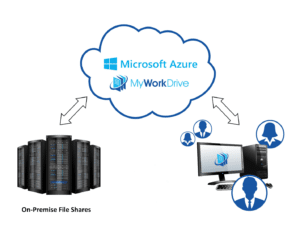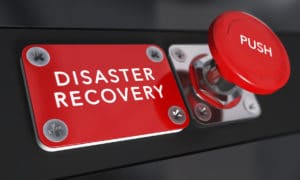Data Leak Prevention and Disaster Recovery Planning
Combine MyWorkDrive with Azure File Share for a File Share Disaster Recovery Solution
The Disaster Recovery Problem
Disaster Recovery Planning isn’t just about data leak prevention. Along with ransomware, malware, viruses, phishing, and other cyberattacks, a serious Digital Protection Officer must plan for natural disasters as well. There’s a lot about Digital Transformation and the Internet of Things but essentially it all boils down to being constantly connected and every device that’s added and every computer networked is another entry point of disaster.
Recently while attending the Gartner CIO Symposium in Orlando, Florida I had a long conversation with the CIO for a small island country that experiences strong hurricanes. The country had been hit hard by several recent hurricanes and their emergency plan included physically moving hard drive back-ups of their data center from low lying areas where government offices were located. Many San Francisco based companies have colocations dispersed throughout the country or state because of earthquakes. Solar farms exist to just power servers since the lack of electricity could render Blockchain completely useless.
What happens to Enterprises that lose their data or have their data breached? They can lose customer trust, clients, investors, and find themselves scrambling to gain back market share or worse yet never recover due to the damage or perceived damage done. Unfortunately, major cyber-attacks have become all too common as bad actors have become more efficient, pervasive, and emboldened. We have all heard the headlines from various sectors including credit cards, credit ratings, political institutions, personal information like medical history, personal emails being publicly leaked, and other nefarious acts. Data leaks and breaches can mean big money for hackers who sell credit card information to the highest bidder especially around major holiday shopping seasons.
What about data centers and cloud platform providers that house other sectors that when data is breached it can mean a national security disaster or a major economic meltdown?
Major sectors including government, healthcare, financial, and educational institutions must depend on stringent security procedures and major disaster planning and contingencies. It’s not just companies like Apple or Amazon who worry about losing data integrity. 2014 gave us the Sony Pictures, JP Morgan Chase, eBay, Home Depot, and Anthem debacles. The Sony Pictures hack got a lot of infamous notoriety because of the North Korea connection. 2016 gave us the Russian attack on the American electoral process. The American power grid is vulnerable. Airlines and airports have been hacked. Now in 2018 it’s common to hear about issues almost on a monthly basis and so much so that there were 40,000 attendees at the RSA Conference in San Francisco this year.
Enterprises and institutions can’t be too big to fail. Disaster recovery is all about planning for the worst and then having a back up plan to that plan. Failovers must be ready to go and be deployed instantly. If a network has been compromised then much like a cancerous tumor, the virus must be excised and extracted quickly before spreading. Shutting the network down may cure the symptom but the malignancy may exist on a cloud platform that you have absolutely no control or ownership over and what then?
Having a hybrid cloud type or private cloud set up where a backup of your most critical files can exist on a non-networked server and either be deployed or retracted and contained as a silo as needed to shore up vulnerabilities is key. In turn you can stay agile as you revert back to the on-premise uncompromised file servers with secure file share remote access provided by MyWorkDrive’s patented technology. Think of a castle with high stone walls and a moat and retractable bridge. When under attack, the bridge goes up, the moat water level rises and the innermost sanctum behind the fortified walls carries on business as usual.
Before you have a major outage and disruption and chaos ensues, you need to have done some homework first. Important preparation includes being very aware of what risks your enterprise will face including how much downtime is manageable, a full inventory of critical digital assets, and identifying all aspects and steps of the back-up process. You will need a redundancy structure and rollback/failover process and identify what applications must stay up and running or be brought back up first and triage as necessary. What is your escalation process and what key stakeholders must be looped in and when do they get notified? The team must establish rules of engagement and then go through drills and concurrently have the best data center provider possible. You should have a full audit and include a full diagram of your network and identify weak points and create redundancies and contingencies accordingly.
The Solution
What if we told you that you could restore end user access to files within minutes of an outage, a system failure, or a power outage? No more need to hit the panic button! Also- what if you didn’t need an expensive DR site to make it work? This isn’t an IT pipe dream. It’s cloud disaster recovery with Azure File Share Sync services! Let us show you how:
In the event of a critical emergency users can instantly connect to a MyWorkDrive server in Azure connected to Azure File Shares to access files and edit documents online from any web browser or mobile device. Once the emergency has passed any changes made are automatically synced back to on-premise storage.
How It Works

Azure File Share Sync enables enterprises with on-premise file shares to sync them to Azure File Shares stored in Microsoft Data Centers or to remote locations. Microsoft has recently announced general availability of Azure File Share Sync and it’s now fully supported. MyWorkDrive has partnered with Microsoft since its initial preview last year – https://www.myworkdrive.com/azure-file-share-sync/.
To get started customers simply sync their file shares to Azure using Microsoft Azure File Share Sync Agents – https://docs.microsoft.com/en-us/azure/storage/files/storage-sync-files-planning, setup two virtual servers in Azure – a backup domain controller for emergency user authentication and a MyWorkDrive Server for users to access files pointed to Azure File Shares synced from on-premise.
Azure File Sync can be implemented with minimal overhead by installing an agent on company file servers. In addition to supporting offsite syncing, Azure File Shares can be connected to Azure Backup. Azure Backup offers Azure backup as a service. It is cloud native and uses file share snapshot technology to capture the point-in-time state of the cloud file share. Since the snapshots are incremental, the storage consumption for backups are minimal.
In an emergency users are instantly able to connect to their company file shares via any Web Browser, Desktop PC or Mobile device! When the emergency is over any changes made are synced back to on-premise storage.
Users can be up and running in minutes and continue productivity, agility, and efficiency with added layers of security after what would have normally brought a company to its knees and a grinding halt.
Utilizing Azure with MyWorkDrive now can be a standard operating procedure in Disaster Recovery Planning for major companies and enterprise size institutions.

